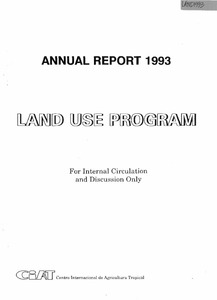Land use studies: Reconciling the Dynamics of Agriculture with the Environment Annual report 1993 Project PE-4
Land Rights and Women's Empowerment in Rural Peru: Insights from Item Response Theory
Women’s land rights are increasingly advocated as an empowerment tool to spur development outcomes. However, empirical evidence of this relationship is limited. In this study we use data from peasant communities in rural Peru to explore the effect of the intra-household allocation of inherited land on women’s empowerment. Empowerment is modeled as a latent variable measured by different influence indicators using a Generalized Structural Equation approach.
Land tenure and agricultural productivity in Ethiopia
This research is being undertaken as an ILCA project with support from the Rockefeller Post-Doctoral Fellowship Programme. There are three objectives. One objective is very similar to that of the World Bank and Niger studies: to determine the effects of land tenure on investment, productivity and efficiency in crop-livestock systems in the Ethiopian highlands.
Land use and agricultural change dynamics in SAT watersheds of southern India
Impact of dynamic land use and land cover changes on the livelihood of local communities and ecosystem services is a major concern. This is particularly evident in most dryland agricultural systems in South Asia. We study land use/land cover (LULC) changes over the last two decades in a watershed (9589 ha) located in semi-arid eco-region in South India (Anantapuram district) using Landsat and IRS imagery. We captured additional data through field observations and focused group discussions.
Land Use Program Annual Report :1993
Land Use Program Annual Report: 2004
Land-use change trajectories up to 2050: insights from a global agro-economic model comparison
Changes in agricultural land use have important implications for environmental services. Previous studies of agricultural land-use futures have been published indicating large uncertainty due to different model assumptions and methodologies. In this article we present a first comprehensive comparison of global agro-economic models that have harmonized drivers of population, GDP, and biophysical yields. The comparison allows us to ask two research questions: (1) How much cropland will be used under different socioeconomic and climate change scenarios?
Large scale land acquisitions and REDD+: a synthesis of conflicts and opportunities
Large scale land acquisitions (LSLA), and Reducing Emissions from Deforestation and forest Degradation (REDD+) are both land based phenomena which when occurring in the same area, can compete with each other for land. A quantitative analysis of country characteristics revealed that land available for agriculture, accessibility, and political stability are key explanatory factors for a country being targeted for LSLA. Surprisingly LSLA occur in countries with lower accessibility.
Large-scale implementation of adaptation and mitigation actions in agriculture
This paper identifies sixteen cases of large-scale actions in the agriculture and forestry sectors that have adaptation and/or mitigation outcomes, and distils lessons from the cases. The cases cover policy and strategy development (including where climate-smart objectives were not the initial aim), climate risk management through insurance, weather information services and social protection, and agricultural initiatives that have a strong link to climate change adaptation and mitigation.
Key lessons learned include:









